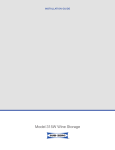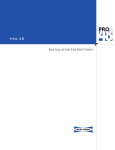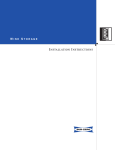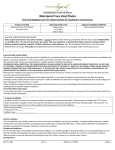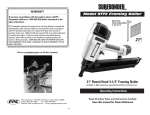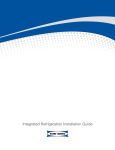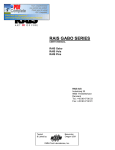Download Maytag 12828121 Use & care guide
Transcript
Installation Your refrigerator was packed carefully for shipment. Remove and discard shelf packaging and tape. Do not remove the serial plate. Location • Do not install refrigerator near oven, radiator or other heat source. If not possible, shield refrigerator with cabinet material. • Do not install where temperature falls below 55° F (13° C) or rises above 110° F (43° C). Malfunction may occur at this temperature. • Refrigerator is designed for indoor household application only. Measuring the Opening When installing your refrigerator, measure carefully. Allow 1⁄2” space at top and 1⁄2” space behind the machine compartment cover (located in the rear) for proper air circulation. Subflooring or floor coverings (i.e. carpet, tile, wood floors, rugs) may make your opening smaller than anticipated. Some clearance may be gained by using the leveling procedure under Leveling. Important: If refrigerator is to be installed into a recess where the top of the refrigerator is completely covered, use distance from floor to top of hinge cap to verify proper clearance. Leveling CAUTION To protect property and refrigerator from damage, observe the following: • Protect vinyl or other flooring with cardboard, rugs, or other protective material. • Do not use power tools when performing leveling procedure. To enhance the appearance and maintain performance, the refrigerator should be level. Note • Complete any required door reversal, panel installation and/or a water supply connection, before leveling. Materials Needed: • 3⁄8” hex head driver • Carpenter’s level 1. Remove toe grille. • Grasp firmly and pull outward to unclip. 2. Remove bottom hinge cover(s). • Place the eraser end of a pencil or similar blunt tool in the cover notch. Notch Location Transporting Your Refrigerator • NEVER transport refrigerator on its side. If an upright position is not possible, lay refrigerator on its back. Allow refrigerator to sit upright for approximately 30 minutes before plugging it in to assure oil returns to the compressor. Plugging the refrigerator in immediately may cause damage to internal parts. • Use an appliance dolly when moving refrigerator. ALWAYS truck refrigerator from its side or back–NEVER from its front. • Use slight pressure to pry the cover loose. • Continue to maintain downward pressure to the notched side of the cover while swinging it off. 3. Using hex head driver, turn the front adjustment screws (A) on each side to raise or lower the front of the refrigerator. • Protect outside finish of refrigerator during transport by wrapping cabinet in blankets or inserting padding between the refrigerator and dolly. 3 • Secure refrigerator to dolly firmly with straps or bungee cords. Thread straps through handles when possible. Do not overtighten. Overtightening restraints may dent or damage outside finish. A B C BA C Installation CAUTION Note • Some models only have adjustment screws “A.” To avoid damage to walls and flooring, protect vinyl or other flooring with cardboard, rugs or other protective material. 4. Using the hex head driver, turn each of these adjustment screws (B) to raise or lower the rear of the refrigerator. 1. Unplug power cord from power source. 5. Using the carpenter’s level, make sure front of refrigerator is 1⁄4” (6 mm) or 1⁄2 bubble higher than back of refrigerator and that the refrigerator is level from side to side. 6. Turn stabilizing legs (C) clockwise until firmly against floor. 7. Turn adjustment screws (A) counterclockwise to allow the full weight of the refrigerator to rest on the stabilizing legs. 8. Replace hinge cover(s). • Position cover into the outer edge of the hinge. • Swing the cover toward the cabinet and snap it into place. 9. Replace the toe grille. Note • For proper reinstallation, ensure the “top” marking on the interior of the toe grille is oriented correctly. • Align the toe grille mounting clips with the lower cabinet slots. • Push the toe grille firmly until it snaps into place. Door and Drawer Removal Some installations require door/drawer removal to transport the refrigerator to its final location. WARNING To avoid electrical shock which can cause severe personal injury or death, observe the following: • Disconnect power to refrigerator before removing doors or drawer. Connect power only after replacing doors or drawer. 2. Remove toe grille and bottom hinge cover(s) (see page 3). 3. Remove top hinge cover from refrigerator door by removing Phillips screw and retain screw and cover for later use. 4. Unscrew 5⁄16” hex head screws from top hinge to remove hinge and retain all screws for later use. 5. Lift right side refrigerator door from center hinge pin. Remove door closure from center hinge pin on the right side and retain for later use. 6. Disconnect wire harness on top of left side refrigerator door top hinge. right side door closure Release two-pin connector by pressing junction point with a flat blade screwdriver or fingernail. Green ground wire remains attached to the hinge. 7. Unscrew 5⁄16” hex head screws from top hinge to remove hinge and retain for later use. Lift left side refrigerator door, along with top hinge, from center hinge pin. Remove center hinge pin with a 5⁄16” hex head driver and retain hinge pin for later use. 8. Remove Phillips screws to remove right and left hinges and retain all screws for later use. 9. Remove both stabilizing brackets with 3⁄8” hex head driver and retain screws for later use. 4 Installation Pullout Freezer Drawer To Install: 1. Pull both rails out to full extension. (select models) DANGER To prevent accidental child entrapment or suffocation risk, do not remove the divider in the top freezer basket. 2. While supporting door front, hook supports into slots located on inside of each slide. WARNING To avoid electrical shock which can cause severe personal injury or death, disconnect power to refrigerator before removing doors. After replacing doors, connect power. Note • All four drawer bracket supports must be in the proper slots for the drawer to function properly. CAUTION To avoid possible injury, product, or property damage, you will need two people to perform the following instructions. To Remove: 1. Pull drawer open to full extension. 2. Tilt the lower basket forward and lift to remove. 3. On each white drawer bracket is a basket cradle with two snap attachments. To release each cradle, unlatch the snaps by pushing them inward, away from the side bracket. Lift the cradles off of the rails. 4. Remove Phillips screw from each of the drawer slides (select models). 3. Lower door front into final position. 4. Replace and tighten Phillips screws that were removed from the drawer slides (select models). 5. Place the basket cradles back onto the drawer slides. Align basket cradle snaps with the slots on the drawer brackets and press each cradle towards the bracket until it clicks. Basket cradle snap attachments 5. Lift top of drawer front to unhook the drawer from the slides. Lift door front out to remove. 6. Tilt the lower basket front down and set it down into the basket cradles. 5 Installation Door Reinstallation 1. Install hinge assemblies: 3. Ensure the handle clips are positioned slightly above the door tabs. Handle Clip • Install center hinge with Phillips screws. 2. Place hinge side of refrigerator door on center hinge pin. • Install top hinge with 5⁄16” hex head screws. Door Tab 4. Rotate the handle so that the handle is flat against the door. 3. While holding refrigerator door upright, tighten down top hinge with 5⁄16” hex head driver. 4. Reconnect two-pin connector. 5. Replace top hinge covers. 5. Push the handle down against the upper door tab just enough to allow it to hang unsupported. Handles If not installed, the handle is located in the interior of the fresh food section or attached to the back of your refrigerator. Remove and discard handle packaging and tape. Front Mount Handle Materials Needed: • Gloves to protect hands • Phillips screwdriver • Plastic door removal card (or 1⁄32” thick plastic card), retain the card Attach Extensions to Handle: 1. Align handle and extension as shown. 2. Place extension in handle opening. 3. Apply slight pressure to both sides of the extension piece. 4. Slide extension until it stops on inside edge of handle. 6. Align bottom of handle with lower door tab. Press upper handle end to door surface and firmly grasp lower end of handle. Gently slide handle upward until bottom of handle settles on door surface, then reverse direction, sliding downward to almost engaging tab with clip. 7. Grasp the handle firmly and slide down until it clicks. The audible click indicates fastening clips are securely interlocked. To Remove: 1. Flex the handle away from the door panel. Simultaneously place door handle removal card underneath the base of the lower handle. Insert the card to the line or until it stops. To Install: 1. The handles are to be oriented as shown. 2. Align front mount door handle clip with the door tabs. 2. Grasp the lower part of the handle firmly and lift to remove. 6 Installation engagement. Then firmly slide the handle to the right until it clicks. The audible “click” indicates that the fastening clips are securely interlocked. Freezer Handle Materials Needed: • Gloves to protect hands. • Phillips screwdriver. • Plastic handle removal card (or 1⁄32” thick plastic card). Retain the card. Notes • There is a slight curve to the freezer handle. To Remove: 1. At the right end, flex the handle base away from the surface of the freezer drawer. Simultaneously slide the door handle removal card that came with your refrigerator under the right side base of the handle. Slide the card to the line indication or until it stops, which will be approximately 11⁄2”. 2. With both hands, firmly grasp the handle towards the right base. • For proper installation, be sure handle is oriented as shown. 3. Slide towards the left, lift and remove from the surface. To Install: 1. Align door handle clips slightly to the left of the tabs attached to the freezer door. 2. Rotate the handle so the left base is flat against the door. Handle Clip Door Tab Handle Base 3. Push the left handle base against the left door tab and slightly to the right, just enough to allow it to hang unsupported. 4. While firmly supporting the left handle base against the door, align the right base of the handle with the right tabs that are attached to the door. 5. Now, while firmly holding the handle at the left and right bases, gently slide the handle towards the right until the right base settles in. The handle should now be flat against the face of the freezer door at both the left and right bases. 7 6. With hands still firmly keeping the handle flat against the freezer door, you may have to reverse directions momentarily to assure clip/tab Installing Front-Mounted Handles for Stainless Steel Doors 1. Loosen lower door clip on door with a phillips screwdriver. 2. Locate predrilled hole at base of handle, and fit hollow end of handle over lower door clip. 3. Fit other end of handle over upper door clip and slide up as far as possible. NOTE: If top of handle does not fit over top clip, loosen lower clip further until fit can be accomplished. 4. Insert phillips screwdriver into predrilled hole at base of handle to tighten screw. Insert plastic button plug into hole. 5. Repeat above steps to install other handle. Installation Removing Front-Mounted Handles for Stainless Steel Doors Removing Front-Mounted Handles for Stainless Steel Freezer Door 1. Remove plastic button plug at base of handle with a very small flat-blade screwdriver. 1. Remove right side plastic button plugs at each end of handle with a very small flat-blade screwdriver. • Insert phillips screwdriver into predrilled hole to remove screw. 2. Slide handle down and remove from door clip. • Insert phillips screwdriver into predrilled hole to remove screw. 2. Slide handle right and remove from door clip. 3. Repeat above steps to remove other handle. Installing Front-Mounted Handles for Stainless Steel Freezer Door 1. Loosen lower door clip on door with a phillips screwdriver Connecting the Water Supply WARNING To reduce the risk of injury or death, follow basic precautions, including the following: 2. Locate predrilled hole at base of handle, and fit hollow end of handle over left door clip. • Read all instructions before installing ice maker. • Do not attempt installation if instructions are not understood or if they are beyond personal skill level. • Observe all local codes and ordinances. 3. Fit other end of handle over left door clip and slide left as far as possible. NOTE: If end of handle does not fit over left clip, loosen right clip further until fit can be accomplished. 4. Insert phillips screwdriver into predrilled hole at end of handle to tighten screw. Insert plastic button plug into hole. • Do not service ice maker unless specifically recommended in Use & Care Guide or published user-repair instructions. • Disconnect power to refrigerator before installing ice maker. • Water damage due to an improper water connection may cause mold/mildew growth. Clean up spills or leakage immediately! cont. 8 Installation 4. Place end of copper tubing into water valve inlet port. Shape tubing slightly. Do not kink – so that tubing feeds straight into inlet port. CAUTION To avoid property damage or possible injury, follow basic precautions, including the following: 5. Slide brass nut over sleeve and screw nut into inlet port. Tighten nut with wrench. • Consult a plumber to connect 1⁄4” O.D. copper tubing to household plumbing to assure compliance with local codes and ordinances. • Confirm water pressure to water valve is between 35 and 100 pounds per square inch, 20 pounds per square inch without filter. • Do not use a self-piercing, or 3⁄16” saddle valve. Both reduce water flow and can become clogged over time, and may cause leaks if repair is attempted. • Tighten nuts by hand to prevent cross threading. Finish tightening nuts with pliers and wrenches. Do not overtighten. • Wait two to three hours before placing refrigerator into final position to check and correct any water leaks. Recheck for leaks after 24 hours. • Verify the copper tubing under the sleeve is smooth and free from defects. Do not reuse an old sleeve. Materials Needed: • 1⁄4” outer diameter flexible copper tubing • Shut-off valve (requires a 1⁄4” hole to be drilled into water supply line before valve attachment) • Adjustable wrench • 1⁄4” hex nut driver Notes • Use copper tubing only for installation. Plastic is less durable and can cause damage. • Add 8’ to tubing length needed to reach water supply for creation of service loop. 1. Create service loop with copper tubing (minimum 2’ diameter). Avoid kinks in the copper tubing when bending it into a service loop. Do not use plastic tubing. 2’ diameter minimum 9 6. Pull on tubing to confirm connection is secure. Connect tubing to frame with C water tubing clamp (C) and turn on water supply. Check for leaks and correct if necessary. Continue to observe the water supply connection for two to three hours prior to moving the refrigerator to its permanent location. 7. Monitor water connection for 24 hours. Correct leaks, if necessary. Opening and Closing Your Fresh Food Doors Your new refrigerator is uniquely designed with two fresh food doors. Either door can be opened or closed independently of one another. hinged seal There is a vertically-hinged section on the left fresh food door. When the left door is closed, the hinged section automatically forms a seal between the two doors when both doors are closed. When the left door is opened, the hinged seal automatically folds inward so that it is out of the way. WARNING 2. Remove plastic cap from water valve inlet port. 3. Place brass nut (A) and sleeve (B) on copper tube end as illustrated. Reminder: Do not use an old sleeve. The nut and sleeve are provided in the use and care packet. IMPORTANT: Do not overtighten. Cross threading may occur. A B To avoid electrical shock which can cause severe personal injury or death, DO NOT attempt to remove the hinged seal from the fresh food section. CAUTION To avoid possible product damage, ALWAYS verify that the hinged seal is folded against the edge of the door prior to closing.









